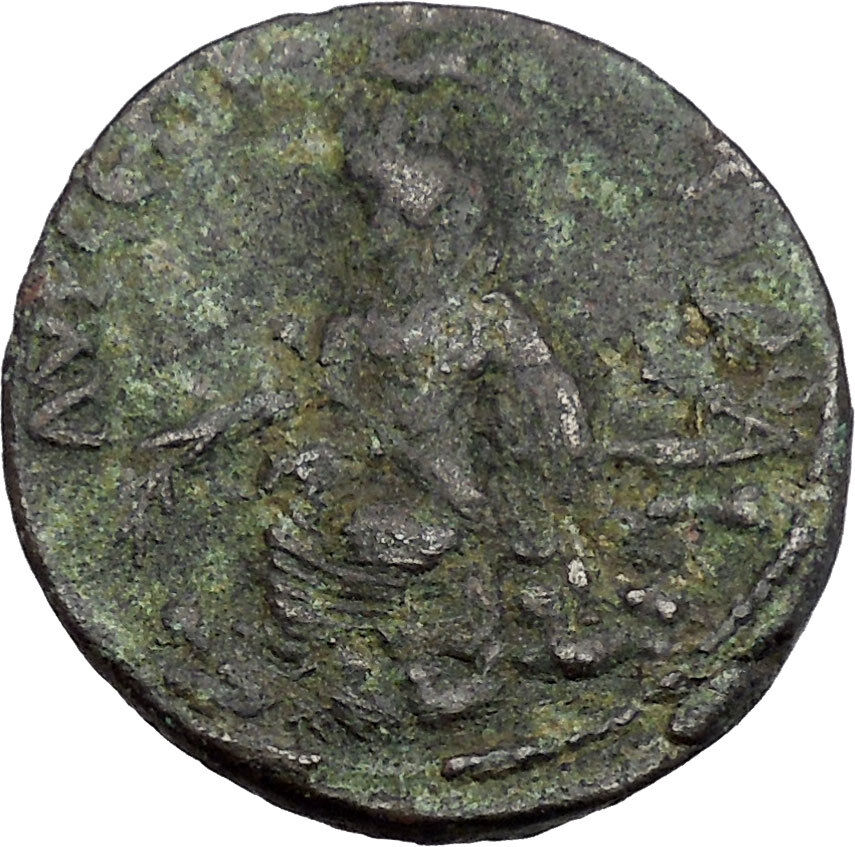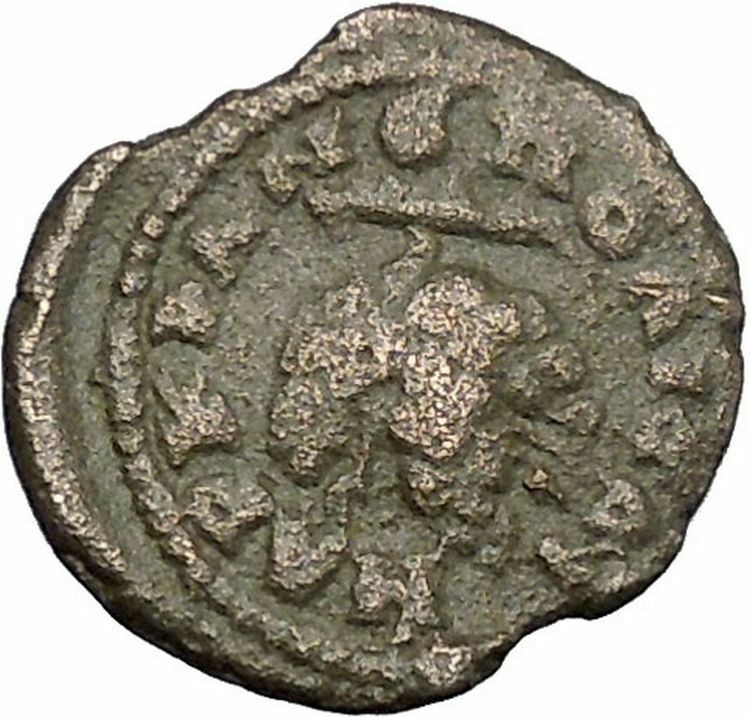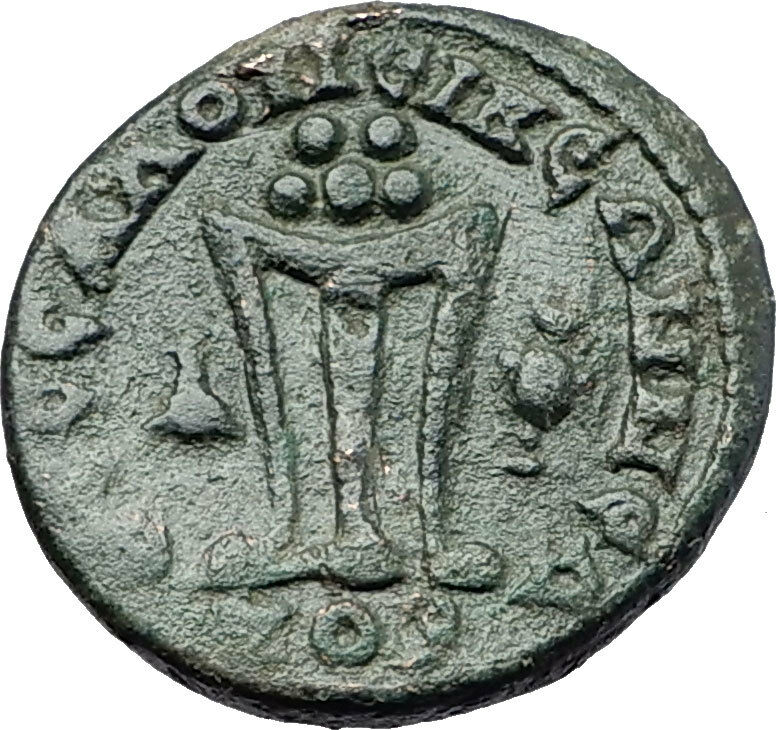|
Gordian III – Roman Emperor: 238-244 A.D. –
Bronze 23mm (6.15 grams) of Odessos in Thrace
AV K M ANT ΓOPΔIANOC, laureate, draped and cuirassed bust right.
OΔHCCЄΩN, Athena seated on shield left, on
left, holding Nike, behind whom Tyche (Fortuna) crowns her with laurel wreath.
You are bidding on the exact
item pictured, provided with a Certificate of Authenticity and Lifetime
Guarantee of Authenticity.
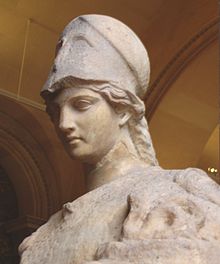
Helmeted Athena with the cista and Erichthonius in his serpent form.
Roman, first century (Louvre
Museum)
In
Greek religion
and
mythology
, Athena or Athene, also
referred to as Pallas Athena/Athene , is the goddess of wisdom, courage,
inspiration, civilization, law and justice, just warfare, mathematics, strength,
strategy, the arts, crafts, and skill.
Minerva
is the
Roman goddess
identified with
Athena.
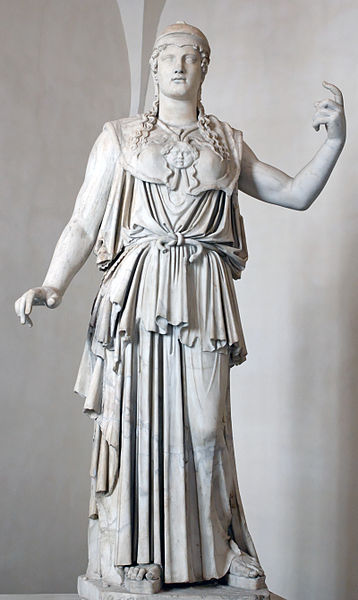
Athena is also a shrewd companion of
heroes and is the
goddess
of heroic endeavour. She is the
virgin
patroness of
Athens
. The Athenians founded the
Parthenon
on the Acropolis of her namesake
city, Athens (Athena Parthenos), in her honour.
Athena’s veneration as the patron of Athens seems to have existed from the
earliest times, and was so persistent that archaic myths about her were recast
to adapt to cultural changes. In her role as a protector of the city (polis),
many people throughout the Greek world worshiped Athena as Athena Polias
(Ἀθηνᾶ Πολιάς “Athena of the city”). The city of
Athens
and the goddess Athena essentially bear
the same name,
“Athenai” meaning “[many] Athenas”.
Patroness
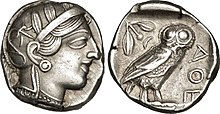
Athenian
tetradrachm
representing the
goddess Athena
Athena as the goddess of philosophy became an aspect of the cult in Classical
Greece during the late 5th century B.C. She is the patroness of various crafts, especially of
weaving
, as Athena Ergane, and was
honored as such at festivals such as
Chalceia
. The metalwork of weapons also fell
under her patronage. She led battles (Athena
Promachos or the warrior maiden Athena Parthenos)
as the disciplined, strategic side of war, in contrast to her brother
Ares, the patron of violence, bloodlust and slaughter—”the raw force
of war”.
Athena’s wisdom includes the cunning intelligence (metis) of such figures
as Odysseus
. Not only was this version of Athena
the opposite of Ares in combat, it was also the polar opposite of the serene
earth goddess version of the deity, Athena Polias.
Athena appears in Greek mythology as the patron and helper of many heroes,
including Odysseus
,
Jason
, and
Heracles
. In
Classical Greek
myths, she never consorts with
a lover, nor does she ever marry,earning the title Athena Parthenos. A remnant of archaic myth depicts her
as the adoptive mother of
Erechtheus
/Erichthonius
through the foiled rape by
Hephaestus
.
Other variants relate that Erichthonius, the serpent that accompanied Athena,
was born to
Gaia
: when the rape failed, the semen landed on
Gaia and impregnated her. After Erechthonius was born, Gaia gave him to Athena.
Though Athena is a goddess of war strategy, she disliked fighting
without
purpose and preferred to use wisdom to settle predicaments.The goddess
only encouraged fighting for a reasonable cause or to resolve
conflict. As patron of Athens she fought in the Trojan war on the side
of the
Achaeans.
Mythology
Lady of Athens
Athena competed with
Poseidon
to be the patron deity of Athens,
which was yet unnamed, in a version of one
founding myth
. They agreed that each would give
the Athenians one gift and that the Athenians would choose the gift they
preferred. Poseidon struck the ground with his
trident
and a salt water spring sprang up; this
gave them a means of trade and water—Athens at its height was a significant sea
power, defeating the
Persian
fleet at the
Battle of Salamis
—but the water was salty and
not very good for drinking.
Athena, however, offered them the first domesticated
olive tree
. The Athenians (or their king,
Cecrops
) accepted the olive tree and with it
the patronage of Athena, for the olive tree brought wood, oil, and food.
Robert Graves
was of the opinion that
“Poseidon’s attempts to take possession of certain cities are political myths”
which reflect the conflict between matriarchal and patriarchal religions.
Other sites of cult
Athena also was the patron goddess of several other Greek cities, notably
Sparta, where the archaic cult of
Athena Alea
had its sanctuaries in the
surrounding villages of
Mantineia
and, notably,
Tegea
. In Sparta itself, the temple of Athena
Khalkíoikos (Athena “of the Brazen House”, often
latinized
as Chalcioecus) was the
grandest and located on the Spartan acropolis; presumably it had a roof of
bronze. The forecourt of the Brazen House was the place where the most solemn
religious functions in Sparta took place.
Tegea was an important religious center of ancient Greece,
containing the Temple of
Athena Alea
. The temenos was founded by
Aleus
,
Pausanias
was informed.
Votive bronzes at the site from the Geometric and Archaic periods take the forms
of horses and deer; there are
sealstone
and
fibulae
. In the Archaic period the nine
villages that underlie Tegea banded together in a
synoecism
to form one city.
Tegea was listed in Homer
‘s
Catalogue of Ships
as one of the cities that
contributed ships and men for the
Achaean assault on Troy
.
Judgment of Paris

Aphrodite is being surveyed by Paris, while Athena (the leftmost
figure) and Hera stand nearby.
El Juicio de Paris
by
Enrique Simonet
, ca. 1904
All the gods and goddesses as well as various mortals were invited to the
marriage of Peleus
and
Thetis
(the eventual parents of
Achilles
). Only
Eris
, goddess of discord, was not invited. She
was annoyed at this, so she arrived with a golden apple inscribed with the word
καλλίστῃ (kallistēi, “for the fairest”), which she threw among the goddesses.
Aphrodite, Hera, and Athena all claimed to be the fairest, and thus the rightful
owner of the apple.
The goddesses chose to place the matter before Zeus, who, not wanting to
favor one of the goddesses, put the choice into the hands of Paris, a
Trojan prince. After bathing in the spring of
Mount Ida
(where Troy was situated), the
goddesses appeared before Paris. The goddesses undressed and presented
themselves to Paris naked, either at his request or for the sake of winning.

Paris is awarding the apple to Aphrodite, while Athena makes a face.
Urteil des Paris by
Anton Raphael Mengs
, ca. 1757
Still, Paris could not decide, as all three were ideally beautiful, so they
resorted to bribes. Hera tried to bribe Paris with control over all
Asia and Europe
, while Athena offered wisdom, fame and
glory in battle, but Aphrodite came forth and whispered to Paris that if he were
to choose her as the fairest he would have the most beautiful mortal woman in
the world as a wife, and he accordingly chose her. This woman was
Helen
, who was, unfortunately for Paris,
already married to King
Menelaus
of
Sparta
. The other two goddesses were enraged by
this and through Helen’s abduction by Paris they brought about the
Trojan War
.

The Parthenon
, Temple of Athena
Parthenos
Masculinity and
feminism
Athena had an “androgynous compromise” that allowed her traits and what she
stood for to be attributed to male and female rulers alike over the course of
history (such as Marie de’ Medici, Anne of Austria, Christina of Sweden, and
Catherine the Great)
J.J. Bachofen advocated that Athena was originally a maternal figure stable
in her security and poise but was caught up and perverted by a patriarchal
society; this was especially the case in Athens. The goddess adapted but could
very easily be seen as a god. He viewed it as “motherless paternity in the place
of fatherless maternity” where once altered, Athena’s character was to be
crystallized as that of a patriarch.
Whereas Bachofen saw the switch to paternity on Athena’s behalf as an
increase of power, Freud on the contrary perceived Athena as an “original mother
goddess divested of her power”. In this interpretation, Athena was demoted to be
only Zeus’s daughter, never allowed the expression of motherhood. Still more
different from Bachofen’s perspective is the lack of role permanency in Freud’s
view: Freud held that time and differing cultures would mold Athena to stand for
what was necessary to them.
Fortuna (Latin:
Fortūna, equivalent to the
Greek
goddess
Tyche
) was the goddess of fortune and
personification
of
luck in
Roman religion
. She might bring good luck or
bad: she could be represented as veiled and blind, as in modern depictions of
Justice
, and came to represent life’s
capriciousness. She was also a goddess of
fate
: as Atrox Fortuna, she claimed the
young lives of the
princeps
Augustus
‘ grandsons
Gaius
and
Lucius
, prospective heirs to the Empire.
Her father was said to be Jupiter and like him, she could also be bountiful . As
Annonaria
she protected grain supplies.
June 11 was sacred to her: on June 24 she was given cult at the festival of
Fors Fortuna
.
Cult

Fortuna and Pontos
Fortuna’s Roman cult was variously attributed to
Servius Tullius
– whose exceptional good
fortune suggested their sexual intimacy
– and to
Ancus Marcius
.
The two earliest temples mentioned in Roman Calendars were outside the city, on
the right bank of the Tiber (in Italian
Trastevere
). The first temple dedicated to Fors
was attributed to the Etruscan Servius Tullius, while the second is known to
have been built in 293 BC as the fulfilment of a Roman promise made during later
Etruscan wars
[6]
The date of dedication of her temples was 24 June, or Midsummer’s Day, when
celebrants from Rome annually floated to the temples downstream from the city.
After undisclosed rituals they then rowed back, garlanded and inebriated.[7]
Also Fortuna had a temple at the
Forum Boarium
. Here Fortuna was twinned with
the cult of
Mater Matuta
(the goddesses shared a festival
on 11 June), and the paired temples have been revealed in the excavation beside
the church of
Sant’Omobono
: the cults are indeed archaic in
date.[8]
Fortuna Primigenia of
Praeneste
was adopted by Romans at the end of
3rd BC in an important cult of Fortuna Publica Populi Romani (the
Official Good Luck of the Roman People) on the
Quirinalis
outside the
Porta Collina
.[9]
No temple at Rome, however, rivalled the magnificence of the Praenestine
sanctuary.
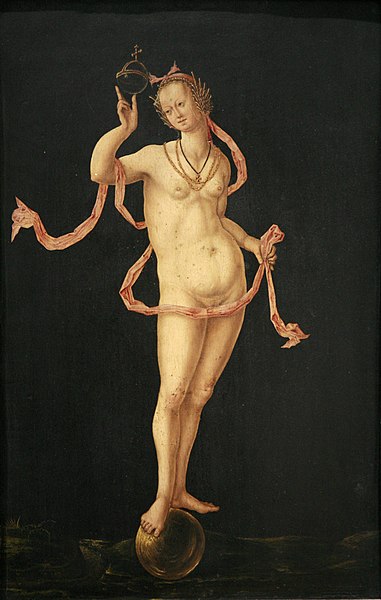
Fortuna lightly balances the
orb
of sovereignty between thumb
and finger in a Dutch painting of ca 1530
(Musée
des Beaux-Arts de Strasbourg)
Fortuna’s identity as personification of chance events was closely tied to
virtus
(strength of character). Public
officials who lacked virtues invited ill-fortune on themselves and Rome:
Sallust
uses the infamous
Catiline
as illustration – “Truly, when in the
place of work, idleness, in place of the
spirit of measure and equity
, caprice and pride
invade, fortune is changed just as with morality”.
An oracle
at the
Temple of Fortuna Primigena
in
Praeneste
used a form of divination in which a
small boy picked out one of various futures that were written on
oak
rods. Cults to Fortuna in her many forms are attested throughout the Roman
world. Dedications have been found to Fortuna Dubia (doubtful fortune),
Fortuna Brevis (fickle or wayward fortune) and Fortuna Mala (bad
fortune).
She is found in a variety of domestic and personal contexts. During the early
Empire, an amulet from the
House of Menander
in
Pompeii
links her to the Egyptian goddess
Isis, as Isis-Fortuna.[11]
She is functionally related to the God
Bonus Eventus
,[12]
who is often represented as her counterpart: both appear on
amulets
and intaglio
engraved gems
across the Roman world.
Her name seems to derive from Vortumna (she who revolves the year).[citation
needed]
The earliest reference to
the Wheel of Fortune
, emblematic of the endless
changes in life between prosperity and disaster, is from 55 BC.
In
Seneca
‘s tragedy Agamemnon, a chorus
addresses Fortuna in terms that would remain almost proverbial, and in a high
heroic ranting mode that Renaissance writers would emulate:
“O Fortune, who dost bestow the throne’s high boon with mocking hand, in
dangerous and doubtful state thou settest the too exalted. Never have
sceptres obtained calm peace or certain tenure; care on care weighs them
down, and ever do fresh storms vex their souls. …great kingdoms sink
of their own weight, and Fortune gives way ‘neath the burden of herself.
Sails swollen with favouring breezes fear blasts too strongly theirs;
the tower which rears its head to the very clouds is beaten by rainy
Auster
…. Whatever Fortune has raised
on high, she lifts but to bring low. Modest estate has longer life; then
happy he whoe’er, content with the common lot, with safe breeze hugs the
shore, and, fearing to trust his skiff to the wider sea, with
unambitious oar keeps close to land.”
Ovid
‘s description is typical of Roman
representations: in a letter from exile
he reflects ruefully on the “goddess who admits by her unsteady wheel her own
fickleness; she always has its apex beneath her swaying foot.”
Odessos in Thrace
Thracians
populated the area densely by 1200 BC.
Miletians
founded the apoikia (trading colony) of
Odessos
towards the end of the 7th century BC (the earliest Greek archaeological
material is dated 600-575 BC), or, according to
Pseudo-Scymnus
, in the time of
Astyages
(here, usually 572-570 BC is suggested), within an earlier Thracian settlement.
The name Odessos, first attested by
Strabo
, was
pre-Greek, perhaps of
Carian
origin. A member of the Pontic
Pentapolis
,
Odessos was a mixed Greco-Thracian community—contact zone between the
Ionians
and the
Thracians (Getae,
Crobyzi, Terizi) of the
hinterland
.
Excavations at nearby Thracian sites have shown uninterrupted occupation from
the 7th to the 4th century and close commercial relations with the colony. The
Greek alphabet has been applied to inscriptions in
Thracian
since at least the 5th century BCE; the Hellenistic city worshipped
a Thracian great god whose cult survived well into the
Roman
period.
Odessos presumably was included in the assessment of the
Delian league
of 425 BC. In 339 BC, it was unsuccessfully besieged by
Philip II
(priests of the Getae persuaded him to conclude a treaty) but
surrendered to
Alexander the Great
in 335 BC, and was later ruled by his
diadochus
Lysimachus
,
against whom it rebelled in 313 BC as part of a coalition with other Pontic
cities and the Getae. The Roman city, Odessus, first included into the
Praefectura orae maritimae and then in 15 AD annexed to the province of
Moesia
(later
Moesia Inferior), covered 47 hectares in present-day central Varna and
had prominent public baths,
Thermae
,
erected in the late 2nd century AD, now the largest Roman remains in Bulgaria
(the building was 100 m wide, 70 m long, and 25 m high) and fourth-largest known
Roman baths in Europe. Major athletic games were held every five years, possibly
attended by
Gordian
III
in 238 AD.
Odessus was an early
Christian
centre, as testified by ruins of ten early basilicas,[6]
a
monophysite
monastery, and indications that one of the
Seventy Disciples
,
Ampliatus
,
follower of
Saint
Andrew
(who, according to the
Bulgarian Orthodox Church
legend, preached in the city in 56 AD), served as
bishop there. In 6th-century imperial documents, it was refereed to as “holiest
city,” sacratissima civitas. In 442, a peace treaty between
Theodosius II
and
Attila
was done at Odessus. In 536,
Justinian
I
made it the seat of the
Quaestura exercitus
ruled by a prefect of Scythia and including
Moesia, Scythia
,
Caria, the
Aegean Islands
and
Cyprus
. The
Jireček
Line
, or the approximate linguistic frontier between Latin and Greek
linguistic influence, ran through the Balkans from Odessus to the Adriatic.
Marcus Antonius Gordianus Pius (January
20, 225
–
February
11
, 244
),
known in
English
as Gordian III,
 was was
Roman
Emperor
from 238 to 244. Gordian was the son of
Antonia Gordiana
and his father was an unnamed Roman Senator who died before
238. Antonia Gordiana was the daughter of Emperor
Gordian I
and younger sister of Emperor
Gordian II
.
Very little is known on his early life before becoming Roman Emperor. Gordian
had assumed the name of his maternal grandfather in 238.
Following the murder of emperor
Alexander Severus
in Moguntiacum (modern
Mainz
), the
capital of the
Roman province
Germania Inferior
,
Maximinus Thrax
was acclaimed emperor, despite strong opposition of the
Roman senate
and the majority of the population. In response to what was
considered in Rome as a rebellion, Gordian’s grandfather and uncle, Gordian I
and II, were proclaimed joint emperors in the
Africa Province
. Their revolt was suppressed within a month by Cappellianus,
governor of Numidia
and a loyal supporter of Maximinus Thrax. The elder Gordians died,
but public opinion cherished their memory as peace loving and literate men,
victims of Maximinus’ oppression.
Meanwhile, Maximinus was on the verge of marching on Rome and
the Senate elected
Pupienus
and Balbinus
as joint emperors. These senators were not popular men and the population of
Rome was still shocked by the elder Gordian’s fate, so that the Senate decided
to take the teenager Gordian, rename him Marcus Antonius Gordianus as his
grandfather, and raise him to the rank of
Caesar
and imperial heir.
Pupienus
and Balbinus
defeated Maximinus, mainly due to the defection of several
legions
,
namely the
Parthica II
who assassinated Maximinus. But their joint reign was
doomed from the start with popular riots, military discontent and even an
enormous fire that consumed Rome in June 238. On
July 29
,
Pupienus and Balbinus were killed by the
Praetorian guard
and Gordian proclaimed sole emperor.
Rule
Due to Gordian’s age, the imperial government was surrendered
to the aristocratic families, who controlled the affairs of Rome through the
senate. In 240,
Sabinianus
revolted in the African province, but the situation was dealt quickly. In 241,
Gordian was married to Furia Sabinia
Tranquillina
, daughter of the newly appointed praetorian prefect,
Timesitheus
. As chief of the Praetorian guard and father in law of the
emperor, Timesitheus quickly became the de facto ruler of the Roman
empire.
In the 3rd century, the Roman frontiers weakened against the
Germanic tribes across the
Rhine
and
Danube
, and the
Sassanid
kingdom across the
Euphrates
increased its own attacks. When the Persians under
Shapur I
invaded Mesopotamia
, the young emperor opened the doors of the
Temple of Janus
for the last time in Roman history, and sent a huge army to
the East. The Sassanids were driven back over the Euphrates and defeated in the
Battle of Resaena
(243). The campaign was a success and Gordian, who had
joined the army, was planning an invasion of the enemy’s territory, when his
father-in-law died in unclear circumstances. Without Timesitheus, the campaign,
and the emperor’s security, were at risk.
Marcus Julius Philippus, also known as
Philip the Arab
, stepped in at this moment as the new Praetorian Prefect and
the campaign proceeded. In the beginning of 244, the Persians counter-attacked.
Persian sources claim that a battle was fought (Battle
of Misiche) near modern
Fallujah
(Iraq)
and resulted in a major Roman defeat and the death of Gordian III[1].
Roman sources do not mention this battle and suggest that Gordian died far away,
upstream of the Euphrates. Although ancient sources often described Philip, who
succeeded Gordian as emperor, as having murdered Gordian at Zaitha (Qalat es
Salihiyah), the cause of Gordian’s death is unknown.
Gordian’s youth and good nature, along with the deaths of his
grandfather and uncle and his own tragic fate at the hands of another usurper,
granted him the everlasting esteem of the Romans. Despite the opposition of the
new emperor, Gordian was deified by the Senate after his death, in order to
appease the population and avoid riots.
|













 was
was
